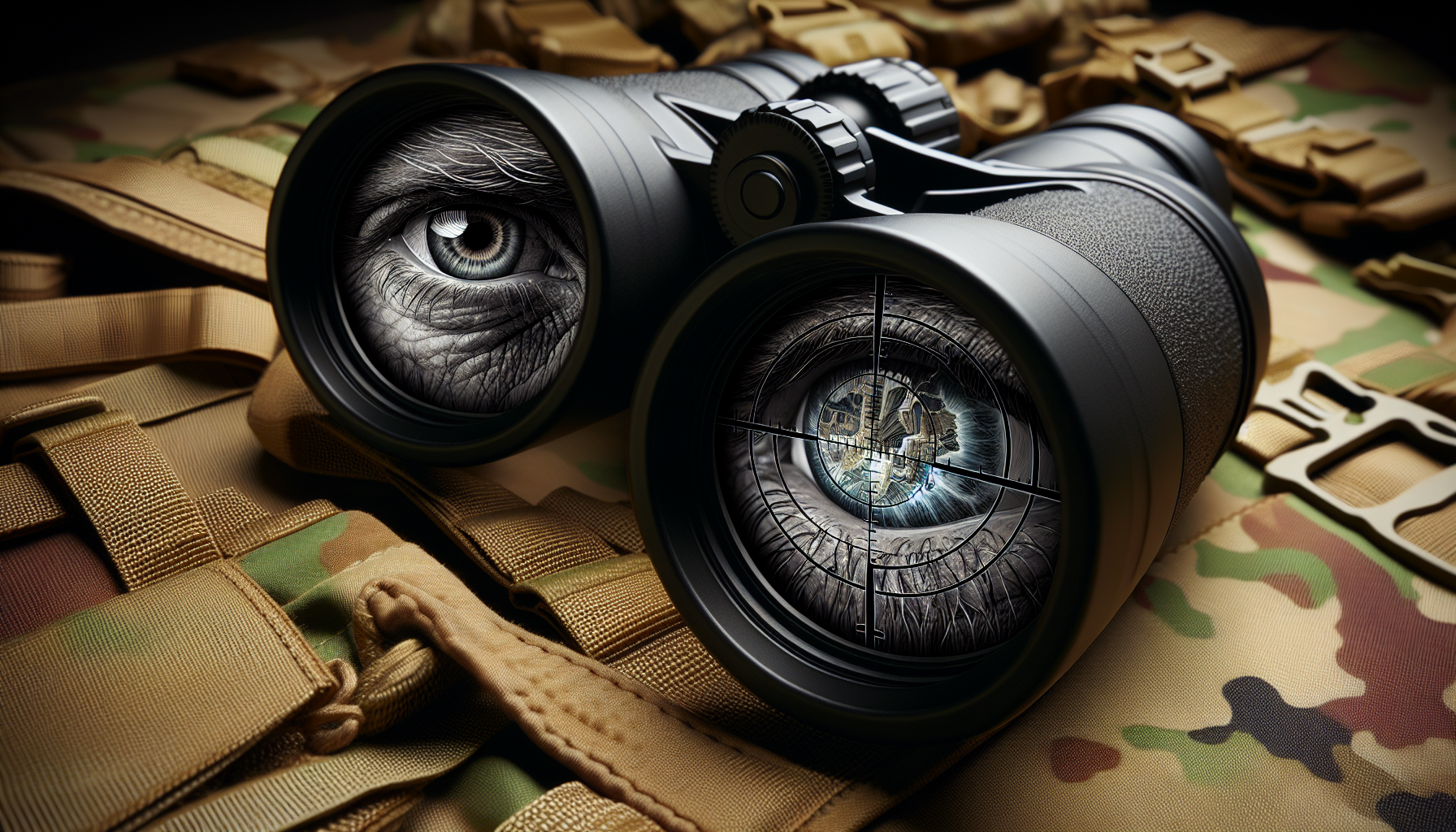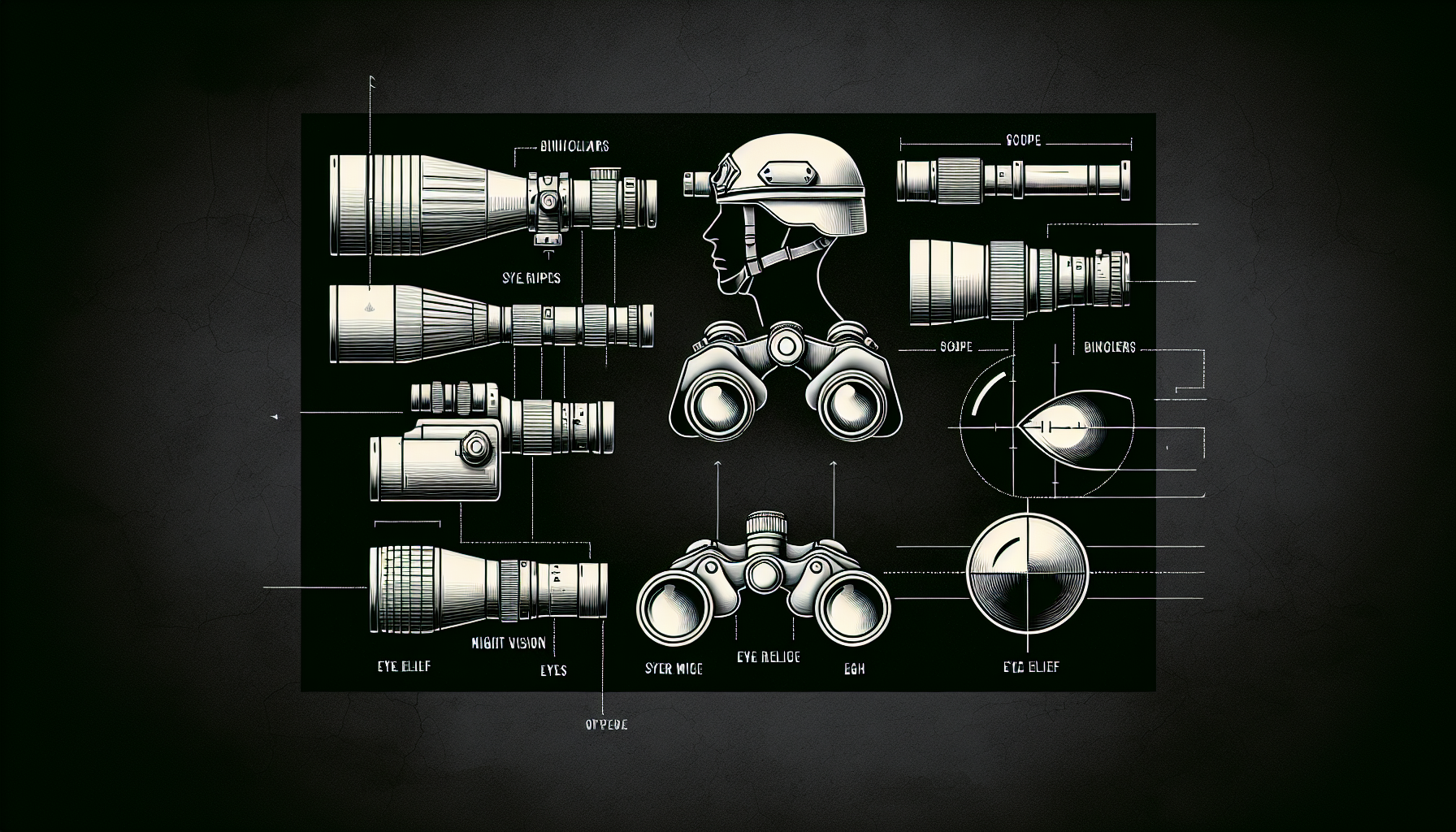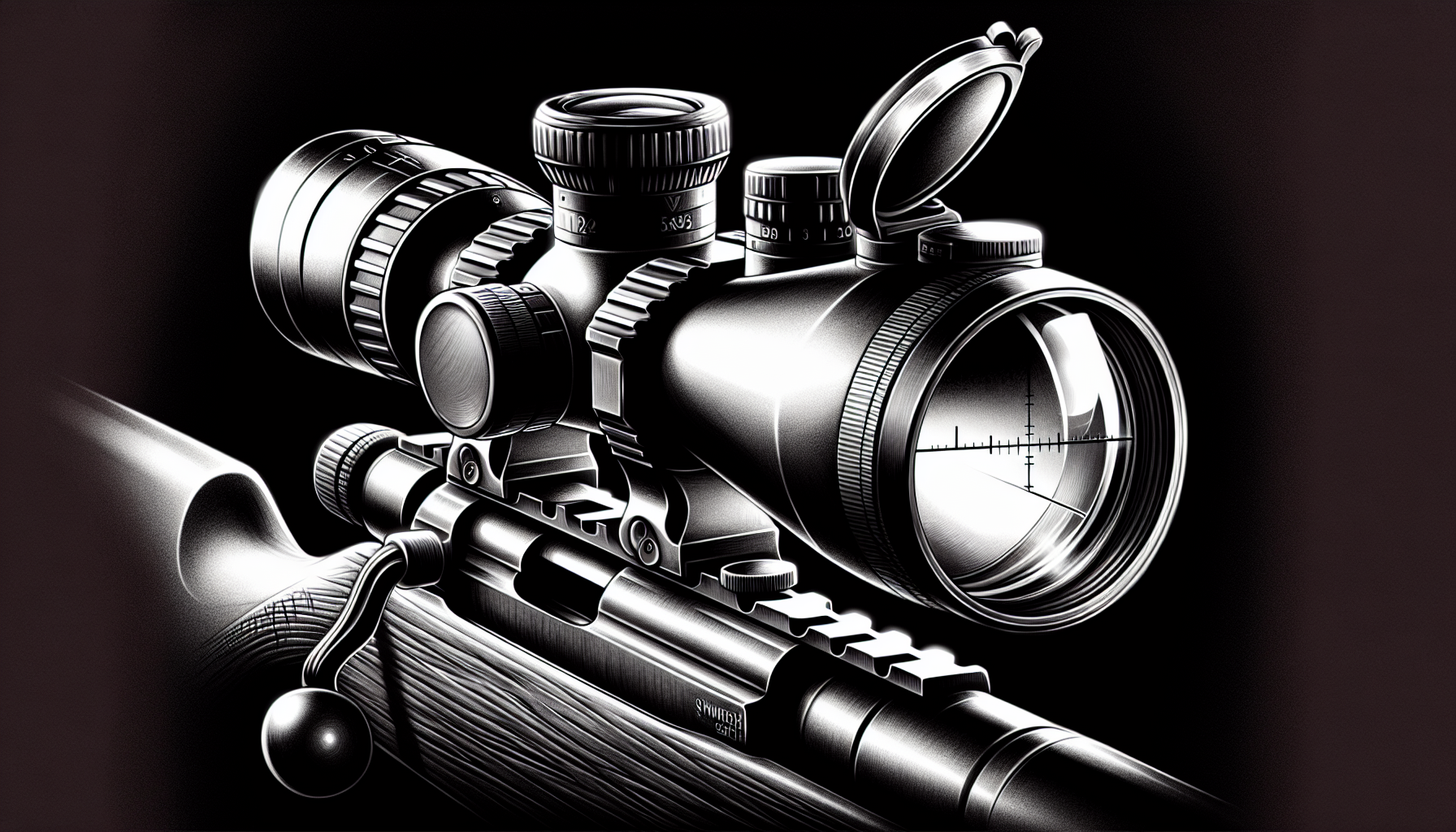Have you ever wondered about the typical eye relief for different types of military optics? When it comes to using these essential tools, understanding the eye relief can greatly enhance your experience. Whether you’re using binoculars, scopes, or any other type of military optical device, having the right eye relief is crucial for comfortable, clear, and immersive viewing. In this article, we will explore the typical eye relief measurements for different types of military optics, giving you a deeper understanding of what to expect and helping you make the most informed decision for your specific needs. Get ready to dive into the world of military optics eye relief and discover the key factors that can make all the difference in your next mission.
Understanding Eye Relief
Definition of Eye Relief
Eye relief refers to the distance between the eyepiece of an optical device, such as a rifle scope or binoculars, and the user’s eye. It is the optimal distance at which the user can obtain a full field of view without experiencing any discomfort or loss of image quality.
Importance of Adequate Eye Relief
Having adequate eye relief is crucial in military optics for several reasons. Firstly, it allows the user to maintain a comfortable shooting position while still being able to see through the optic. This is especially important during long hours of surveillance or while engaging targets in high-stress situations. Additionally, proper eye relief ensures that the user’s eye is protected from recoil or any other impacts caused by the firearm or optic.
Consequences of Insufficient Eye Relief
Conversely, insufficient eye relief can result in various negative consequences. One of the most common issues is known as “scope bite,” which occurs when the scope recoils and hits the shooter’s eyebrow or forehead. This can cause injuries and significant discomfort, compromising the shooter’s ability to effectively engage targets. Insufficient eye relief can also result in a small field of view, making it challenging to locate and track targets quickly and accurately.
Eye Relief in Different Types of Military Optics
Eye Relief in Rifle Scopes
Rifle scopes, being one of the primary optical devices used in military applications, typically have a specific eye relief distance. The average eye relief for most rifle scopes ranges from 3 to 4 inches, although some models offer longer eye relief up to 5 or 6 inches. The exact eye relief distance may vary depending on the magnification power and design of the scope.
Eye Relief in Spotting Scopes
Spotting scopes, commonly used for long-range observation and target detection, have longer eye relief compared to rifle scopes. The average eye relief for spotting scopes ranges from 14 to 20 inches. The extended eye relief allows for comfortable and prolonged observation without straining the user’s eyes.
Eye Relief in Binoculars
Binoculars used for military purposes usually have a similar eye relief distance to rifle scopes, ranging from 3 to 4 inches. The compact size of binoculars makes it essential to maintain a comfortable distance between the user’s eyes and the eyepieces to ensure a clear and unobstructed view. Some high-end binoculars may offer longer eye relief to accommodate users who wear eyeglasses.
Eye Relief in Night Vision Devices
Night vision devices, such as goggles or scopes, have specific requirements for eye relief due to the nature of their technology. The average eye relief for night vision devices varies between 0.8 and 1.5 inches. Since night vision devices are often used in low-light or dark conditions, maintaining a proper eye relief distance is crucial to avoid eyestrain and maximize the effectiveness of the night vision technology.

Factors Influencing Eye Relief
Magnification Power
The magnification power of an optic has a significant impact on the required eye relief distance. Generally, higher magnification scopes or binoculars will have shorter eye relief distances compared to lower magnification optics. This is because higher magnification optics typically have narrower fields of view, requiring the user to position their eye closer to the eyepiece to see the entire image.
Size and Shape of the Optic
The physical dimensions and shape of an optic also play a role in determining the appropriate eye relief distance. Larger and bulkier optics may need to be positioned further away from the user’s eye to maintain a comfortable viewing experience. Likewise, the shape of the eyepiece, such as a cup-shaped or contoured design, can affect the placement of the user’s eye and influence the optimal eye relief distance.
Design and Construction of the Optic
The design and construction of the optic, specifically the eyepiece design, can impact eye relief. Some optics incorporate features like adjustable eyecups or eyepieces with extended relief, allowing users with different vision needs or those wearing eyeglasses to achieve a comfortable viewing distance. Additionally, the overall quality of the optic and the precision of its lens coatings can affect the clarity and brightness of the image, enhancing the overall viewing experience.
User’s Comfort and Vision
The individual user’s comfort and vision also contribute to finding the appropriate eye relief distance. Factors such as the user’s eye socket shape, the presence of eyeglasses or protective eyewear, or even personal preferences can influence the optimal eye relief distance. Optics that offer customizable eye relief options can be beneficial in accommodating a wide range of users with different vision requirements and comfort preferences.
Special Considerations for Military Optics
Reliability Under Harsh Conditions
Military optics must withstand and perform optimally under extreme conditions, including harsh climates, shocks, vibrations, and exposure to dust, water, and other elements. The design and construction of military optics take into account the need for robustness and durability, ensuring that the optics maintain their eye relief specifications even in the toughest environments.
Rapid Target Acquisition
In military operations, quick target acquisition is crucial. Optics with generous eye relief enable users to acquire targets rapidly, align their sights, and engage with precision. Insufficient eye relief can lead to delays in target acquisition and hinder the shooter’s effectiveness in time-sensitive situations.
Night and Low-Light Operation
Military operations often take place during low-light or nighttime conditions, requiring optics with reliable night vision capabilities. Optics with sufficient eye relief for night vision devices allow users to comfortably view the enhanced images without straining their eyes, even during extended periods of use. Clear and unobstructed vision is essential for effective performance in these situations.
Protection Against Recoil and Other Impacts
Military firearms can generate significant recoil forces that can potentially injure the users if eye relief is insufficient. Optics designed for military applications incorporate features that protect against recoil and other impacts, ensuring that the user’s eye remains safe and free from injuries while maintaining the necessary eye relief distance.
Eye Relief and Military Optics Specifications
Standard Eye Relief in Military Optics
The standard eye relief for military optics varies depending on the specific type and intended application. However, for rifle scopes, a typical standard eye relief ranges from 3 to 4 inches. Spotting scopes and binoculars generally follow a similar range for standard eye relief.
Variable Eye Relief in Military Optics
Some military optics offer variable eye relief, allowing the user to adjust the distance based on their individual needs and preferences. Variable eye relief optics can be beneficial to accommodate different shooting positions, eye sockets, or the use of eyeglasses.
Long Eye Relief (LER) in Military Optics
Long eye relief (LER) optics provide more extended eye relief distances than standard optics. They are particularly useful for shooters who prefer a more extended distance between their eye and the optic, such as those who wear eyeglasses or need extra comfort during extended use. LER optics typically have eye relief distances of 4.5 inches or longer.
Ultra-Long Eye Relief (UER) in Military Optics
For special applications or specific user requirements, some military optics offer ultra-long eye relief (UER). These optics provide eye relief distances of 9 inches or more, allowing for greater flexibility in positioning and accommodating unique preferences or equipment configurations.
Comparative Analysis of Typical Eye Relief in Military Optics
Eye Relief in American Military Optics
American military optics, known for their quality and innovation, generally offer standard eye relief distances ranging from 3 to 4 inches. Several renowned American manufacturers prioritize user comfort and eye safety, incorporating features like adjustable eyecups or compensating for eyebox issues in their designs.
Eye Relief in Russian Military Optics
Russian military optics often prioritize robustness and reliability while maintaining competitive eye relief specifications. Standard eye relief distances in Russian military optics commonly range from 3 to 4 inches. Some Russian optics may have slightly longer eye relief distances to accommodate users wearing protective eyewear or equipment.
Eye Relief in German Military Optics
German military optics are revered for their precision engineering and exceptional image quality. Standard eye relief distances in German-made optics typically fall within the 3-4 inch range, with a focus on providing clear and comfortable views for the user.
Eye Relief in Israeli Military Optics
Israeli military optics excel in offering advanced technology and versatility. The standard eye relief distances in Israeli optics are often on par with those of American and European manufacturers, ranging from 3 to 4 inches, ensuring a high level of user comfort and effectiveness.

Adjusting Eye Relief in Military Optics
Procedure to Adjust Eye Relief
Adjusting the eye relief in military optics is important to ensure optimal comfort and performance. To adjust the eye relief, follow these steps:
- Loosen any locking mechanisms or adjustments on the optic’s eyepiece or eyecup.
- Position the optic to align with your shooting position.
- Move the optic closer or further away from your eye until you obtain a full field of view and a comfortable viewing experience.
- Securely tighten any locking mechanisms or adjustments to maintain the desired eye relief distance.
Safety Precautions During Adjustment
When adjusting eye relief, it is essential to take certain safety precautions to protect both yourself and the optic:
- Ensure that the firearm is unloaded and in a safe condition before making any adjustments to the optic.
- Handle the optic with care, avoiding any rough or forceful movements that may damage the optic or cause injury.
- Reference the optic’s manual or consult with a knowledgeable professional if you are unsure about the adjustment procedure of a specific optic.
Impact of Adjustment on Optical Performance
Adjusting the eye relief distance in military optics should not significantly impact the optical performance, assuming the optic is properly designed and manufactured. However, it is important to note that moving the optic closer or further away from the eye may slightly affect the image clarity, field of view, or eyebox size. Finding the right balance between comfortable eye relief and optimal optical performance is crucial for maximizing the effectiveness of the optic.
Latest Developments in Eye Relief Technology
Advancements in Optic Design for Enhanced Eye Relief
Advancements in optic design have led to improvements in eye relief technology. Manufacturers are utilizing innovative engineering techniques and materials to create optics with longer and more flexible eye relief distances. These advancements ensure that users can achieve comfortable and clear views without compromising the overall optical performance of the optic.
Controls and Adjustability Features for Eye Relief
Modern military optics often incorporate controls and adjustability features specifically designed to enhance eye relief options. Adjustable eyecups, diopter adjustments, or even telescopic eyepiece designs allow users to fine-tune the eye relief distance to their own preferences and requirements. These features provide added versatility and customization for users with different shooting positions, vision needs, or protective eyewear.
Impact of Digital Technology on Eye Relief
The integration of digital technology in military optics has opened up new possibilities for eye relief. Digital displays, such as heads-up displays (HUDs) or augmented reality (AR) overlays, can provide vital information without obstructing the user’s view or altering the required eye relief distance. These advancements further enhance the usability and effectiveness of military optics by providing a wealth of information while maintaining optimal eye relief.

Challenges and Limitations of Eye Relief in Military Optics
Physical Limitations of Eye Relief
The physical limitations of optics, such as size, weight, and design constraints, can sometimes limit the maximum eye relief distance that can be achieved. Balancing the need for longer eye relief with maintaining a compact and lightweight optic can be challenging, particularly in military applications where portability is critical.
Impact of Environmental Factors on Eye Relief
Harsh environmental conditions, such as extreme temperatures, humidity, dust, or water exposure, can potentially affect the eye relief performance of military optics. Fogging, moisture buildup, or debris on the eyepiece can obstruct the user’s view or cause discomfort. Optics designed for military use undergo rigorous testing to ensure they can withstand and perform under various environmental conditions, minimizing the impact on eye relief.
Cost Implications for High Eye Relief
Optics with extended eye relief distances often require more intricate designs, precise manufacturing, and high-quality materials, which can potentially increase the cost of the optic. The added complexity and specialized features needed to achieve longer eye relief may result in higher pricing. However, the benefits of improved eye relief and the enhanced user experience may outweigh the additional cost for certain users or mission requirements.
Future Prospects for Eye Relief in Military Optics
Possible Improvements in Eye Relief Technology
As technology continues to advance, the future holds promising prospects for further improvements in eye relief technology. Advancements in materials, lens coatings, and optic design techniques may allow for even longer and more flexible eye relief distances without compromising overall optical performance. Additionally, the integration of adaptive systems or smart technologies could optimize eye relief settings automatically based on individual users’ needs and shooting situations.
Emerging Trends and Innovations in Eye Relief
Emerging trends in the field of eye relief include the development of optics with customizable eye relief options, adaptable eyecup designs, and advancements in head-mounted displays. These trends aim to provide users with more comfort, flexibility, and situational awareness, allowing for quicker target acquisition and improved performance in various operational scenarios.
Potential Impact of Emerging Technologies on Eye Relief
The ongoing development of emerging technologies, such as augmented reality (AR) optics, micro-displays, and advanced image processing algorithms, may have a significant impact on eye relief in military optics. These technologies have the potential to revolutionize the way users perceive and interact with their surroundings, potentially leading to new approaches to eye relief design and optimization.
In conclusion, understanding eye relief is vital when it comes to military optics. Adequate eye relief ensures user comfort, target acquisition efficiency, and eye safety, while insufficient eye relief can lead to discomfort, injuries, and reduced effectiveness. Factors such as magnification power, optic size and shape, design, construction, and user comfort all influence the optimal eye relief distance. Military optics manufacturers continuously strive to improve eye relief technology and incorporate features that enhance usability and performance, even under harsh conditions. With ongoing advancements and emerging technologies, the future prospects for eye relief in military optics look promising, opening up new possibilities for improved user experiences and operational effectiveness.



